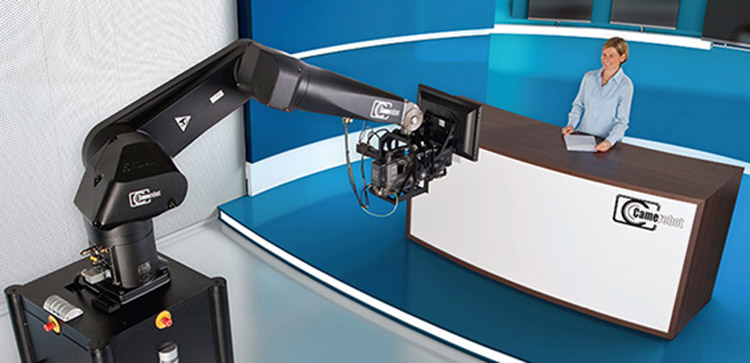
Robotic arms being employed as camera operators
If you’re an enthusiast who occasionally makes a YouTube video, you probably use the webcam integrated with your computer.
But if you’re more serious, you probably buy yourself good-quality video and audio equipment and your productions are of a higher standard.
Take one step further on from that and what’s possible is that you avail yourself of the services of a camera operator, someone who can move the camera to follow you around as you show us how to make that croissant and coffee we all so desperately need first thing in the morning.
Except your camera operator need not be human anymore – it could be a robot.
Any robotic arm could be programmed and equipped to operate a camera, or at least hold it and point it in a specific direction.
But much more could be done. A robotic arm could be programmed not only to perform choreographed movements, it could also be coded to be autonomous and responsive to the presenter’s movements, eventually.
One thing that might be an issue is the noise a robot makes – the mechanical whirring sounds of gears and components inside the arm can be noticeable.
That’s not something you necessarily want in your final edit – you want something that is silent and has a certain fluidity of movement.
These are probably among the issues some developers of hardware and software are grappling with as they try to bring robotic arms into television and film studios.
The idea would seem to have a lot of potential since a human camera operator can be expensive, and – if the technology is right – it’s a concept that could eliminate another relatively tedious job.
Of course, photography, cinematography, and camera work can be creative or even artistic, but a lot of the time it’s simply about keeping the camera pointed in the right direction.
And while humans are generally capable of greater flexibility in their movements, the precise manoeuvres of a robot would seem to give it an added advantage.

A company called Motorized Precision has taken this and many other advantages that robotic arms perhaps possess and has combined them into what appears to be a pretty useful robotic camera system called “Kira”.
Apparently, Kira is not the first robot to operate a camera, but Motorized Precision claims it is “intuitive and nimble in ways no camera robot has ever been”.
In fact, they are quite gushing about it, referring to Kira as a “she” and saying that “her grace is stunning”, adding that “her speed and power are positively unmatched”.
It appears that the Kira system utilises a six-axis, ABB industrial robotic arm but we have yet to confirm that.
It’s capable of high-speed, precise movements, and, using the company’s MP Studio software, the camera at the end of the arm can be used to control focus, iris and zoom.
Other functions such as the ability to repeat camera movements as well as time-lapse filming are also within the capabilities of the Kira and MP Studio solution.
Motorized Precision has been around for a couple of years now and has showcased its Kira system at broadcast technology trade shows around the world.
The most well-known event is probably the NAB Show, which this year takes place from April 7th to 10th, in Las Vegas.
It’s probably too early to say much about the market potential for this company and others developing similar systems.
Certainly, Motorized Precision would seem to have the right mix of skills to take the business forward – cinematographers, designers, coders and robotics experts.
Sean Brown, CEO at Motorized Precision, says the company was set up by professional photographers and filmmakers, so it knows the value of intuitive and accessible technology.
“We designed Kira to be just that, making cinema robotics easier to use for cinematographers and directors, helping them plan, capture and achieve incredible results.”
Motorized Precision is a US company so it has a huge potential market. Across the Atlantic, in Europe, where the market is also significant in size, there is at least one other company developing similar technology.
Camerobot, a Germany-based company, has built a robot-controlled camera-operating solution, based on and around a Stäubli industrial robotic arm (main picture). In fact, Camerobot is a subsidiary of Stäubli, one of the largest robot makers in the world.
Camerobot is somewhat more well-established than Motorized Precision and already has a range of solutions in operation at television studios across Europe.
The company says its Camerobot RX165Lcam has been developed for operation in television studios in order to create dynamic and impressive camera movements.
It‘s particularly targeted at producers of news programmes and other highly-structured shows.

In an interview with Robotics and Automation News, Peter Pühringer, Camerobot’s manager, says: “Basically, the Camerobot is an industrial robotic system for broadcast studios in order to make the camera movements automatic.
“It’s very important that the camera always moves in the same way, so it looks consistent on the screen.
“If there’s a human operator behind the camera, they could make cameras that are always different – depends on the human camera operator.
“They can make things look different each time, the framing is not always the same, so the screen is not always the same.
“With a robotic system, you can produce, for example, a news show, in the same way, every time.”
(Additional reporting by Abdul Montaqim.)


